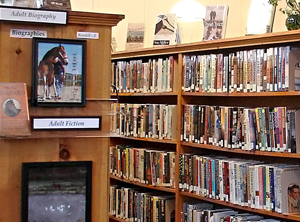Horse show
Vanessa Wright takes her equine photography to libraries around the country.
By Katherine Muhlenkamp
Photography by Vanessa Wright

In February 2009, 65 photos from the Literary Horse were exhibited at West Buxton (Maine) Public Library.
Vanessa Wright, AB’98, grew up in Rochester, New York, but her most vivid childhood memories are of summers in Saratoga Springs, where her grandparents had a home directly behind the famed racetrack. She spent her days at a stable, hauling water, mixing feeds, raking stalls, and sometimes clipping the lead to a school horse and setting off for a day-long ride. Throughout the year Wright devoured horse-themed stories: the Greek myth of Castor and Pollux, C. S. Lewis’s The Horse and His Boy, Marguerite Henry’s King of the Wind.
Those hours of riding and reading served her well. Wright, now an equine photographer, organized her photographs of horses and riders into an exhibition, The Literary Horse: When Legends Come to Life. Debuting in May 2008 and running through 2012, the exhibit travels to libraries across the country. The full collection includes more than 150 photos, each paired with a related quotation from a classic literary work such as Jane Eyre or Black Beauty. Wright’s subjects include Sue Williams, owner of the 1984 US Olympic gold medalist Abdullah; Mustang rescue activist Mona Jerome; and young equestrians with sprightly horses. As of February, the exhibit has attracted more than 150,000 visitors at 31 libraries and been featured in Horse & Rider and Equus.
Until 2002, Wright was most involved with horses as a rider and instructor. As a College student majoring in Fundamentals, she rode at a Chicago indoor arena and was a summer-camp equestrian instructor. While working as a teacher in Virginia and later for online-education company K12, she competed in “eventing,” which she describes as “a kind of triathlon for horses and riders.” In 2001 Wright bought her first horse, a Thoroughbred-Lipizzan gelding named Pegasus—named, she notes, “at birth, by his breeder, not me.” She hoped to compete at the World Equestrian Games and dreamed of the Olympics. Then Pegasus tripped during training, causing both horse and rider to fall. Wright hurt her back and Pegasus injured his leg; their competitive careers were over.
Wright moved to New Hampshire in 2003 and began building a career in equine writing and photography. Although she has been taking pictures of horses since her grandparents gave her a 110 camera as a child, she has no formal training in photography beyond “reading each camera’s manual.” Wright eventually published essays and short stories with accompanying photos in horse-related volumes. Her nonfiction piece in Horses with a Mission: Extraordinary True Stories of Equine Service (New World Library, 2009) chronicles Pegasus’s midlife work as a foal-sitter, or guardian, to orphaned, rescued, or challenged young horses.
During one newsletter photo shoot in 2007, Pegasus plunked down in a puddle, ruining Wright’s careful grooming. Exasperated, she shot one frame of the muddied horse and then headed home. She downloaded the photo and was stunned to see that a beam of sunlight had illuminated his body, and wind had picked up his mane and tail, creating the appearance of wings: It was “as if my broken horse were the mythical winged Pegasus.”
The photo inspired her to create The Literary Horse. From the beginning, Wright envisioned the project as a traveling exhibit for public and school libraries. Two of the exhibit’s goals, she explains, are to promote literacy through the quoted works and to reach a broad group of people through “the democracy, and thus the power and value, of the public library.”
Wright traveled the United States and abroad to photograph horses and their riders, owners, and caretakers. She sought to convey the grace and fortitude of her diverse subjects: Olympian, Special Olympian, and novice riders; service, companion, and champion horses.
After matching the images with quotations inspired by a subject’s qualities or the activity in the photograph, Wright created a 15-page document of exhibit-themed educational event ideas: puppet shows, sing-alongs, books clubs, readings. She then pitched The Literary Horse to libraries, free of charge.
The exhibit has traveled the East Coast and to horse-friendly areas including Lexington, Kentucky, for an exhibit that coincided with last fall’s World Equestrian Games, and La Grange, Kentucky, for the 2009 Derby in nearby Louisville. The show heads to Canada in August. Libraries have reported traffic increases of up to 75 percent while the exhibit is up, typically for about a month.
Wright continues to shoot new images for The Literary Horse, maintains her blog Great Books for Horse Lovers, and is writing an anthology of horse stories from the Massachusetts Society for the Prevention of Cruelty to Animals’ 143-year history. She’s also at work on a novel that retells the Pegasus myth, sometimes with her own Pegasus looking over her shoulder. “I’ve been writing it in snatches in airports, in pastures, and, a few times, in notes on the back of whichever hand I’m using to hold my camera.”
